Twistweight
Twistweight should perhaps be mentioned before or talked about more than swingweight because I feel like there are many misconceptions about this parameter. Manufacturers don’t give out data on the twistweight for the rackets and we have to dig deeper in order to find the twistweight information. Luckily friends at Tennis Warehouse University are doing a great job and have a database for racket parameters including twistweight (http://twu.tennis-warehouse.com/cgi-bin/compareracquets.cgi). The problem is again that those numbers are only the average of a couple of rackets that the measure and data like this should only be used for comparisons when selecting a racket etc. Unfortunately, there is no easy way to measure twistweight, but I’m actively working on something to bring you a »do it yourself« method for measuring twistweight.
It’s no coincidence that manufacturers don’t talk about twistweight, but instead, when they increase twistweight they claim they increased the stability of the racket without increasing the total mass of the racket. They achieve this by redistributing the weight and using different weaves of the materials. The trend today is light rackets with high twistweight, something that in the past could only be found in oversized rackets. Twistweight of 15 (considered a high TW number) could only be found in beginner rackets with head sizes of 105 and above square inches. Now what high TW values do, is they make rackets more forgiving, meaning you don’t lose control and power when you don’t hit the ball in the center of the string bed. But there is, of course, a big downside. The moment of inertia about the centerline of the racket is also higher, making the racket less maneuvrable, which results in a more linear swing path, which decreases the overall ceiling of the racket. And let’s not forget that it’s actually harder to hit the ball in the center of the string bed if it is less manoeuvrable especially in a fast-paced exchange. The only thing high twistweight is good for is for blocking and pushing the ball. I believe that professional players don’t need a hight twistweight racket, thus a forgiving racket. A low twistweight rewards clean striking tennis. The only problem is, that they don’t really have a lot to chose from because almost every high-end racket today has a high twistweight.
The perfect example is Nadal with his Aero Pro Drive Original (yes he is still using the mould of the racket released almost 2 decades ago). The racket has a low twistweight, which enables him to hit those whippy forehands and crazy topspin. Low twistweight is also the reason why Nadal likes to stand so far back on the return and is so dominant on clay. He needs more time to see the ball and time it well, so he doesn’t hit it outside the sweet spot. In the periods when Nadal wasn’t at his best (around 2015/2016), he didn’t move that well, and that’s why he wasn’t timing the forehand well and was hitting a lot of balls short, because of the off-centre shots. The most recent model from the Aero family has a TW of around 15, which is very high, making it impossible to play like Nadal. Don’t get me wrong, the majority of people using the Pure Aero benefit more from it than they would from the Aero Pro Drive Original, but I think that Babolat and other companies should still make some low twistweight rackets. There are some exceptions, but more on that later.
Twistweight definition
Twistweight is a similar parameter to swingweight in a sense that it is also a rotational inertia, but about a different axis than swingweight. Like swingweight, that ranges from around 200-400, twistweight can go as low as 10 or less and up to 20. I consider anything above 15 a very high twistweight. Now let’s take a look at the axes again.
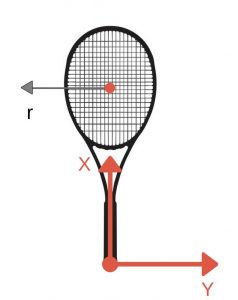
Here the axis of rotation is X, and the r is the distance of mass from the vertical centerline of the racket. We can start with the same equation (1) for the moment of inertia.
\(I_{p}=\iiint \rho _{\left( x,y,z\right) }\cdot \left| \left| r\right| \right| ^{2}dxdydz\)
(1)
The difference is that twistweight has no offset like swingweight (10 cm) and TW is equal to the moment of inertia about the X-axis. The discretized equation (2) takes a form of:
\(TW=I _{p x}=\sum ^{n}_{i=1}\left( m_{i}\left( r_{i,x}\right) ^{2}\right)\)
(2)
The difference is also, that we need to consider mass in both directions (left and right) from the X-axis, unlike with swingweight where we don’t consider the mass bellow the 10 cm from the Y-axis. Usually, the racket is symmetrical around the X-axis, and when we add weight on the sides of the hoop, we usually distribute is evenly, meaning 4 grams at 3&6 o’clock locations would mean 4 strips of lead, 1 gram each as shown on the picture below.
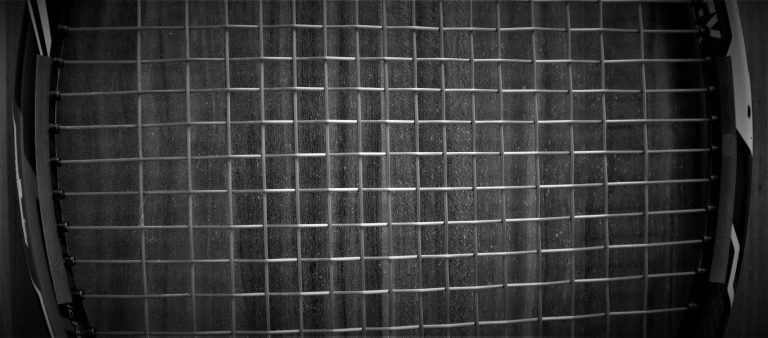
Calculating twistweight
Let’s take a look at the example I mentioned above. Suppose we add 4 strips of lead at 3&9 locations. If one strip weights 1 g, this would mean 4 grams at r = 12,5 cm as shown on the picture below.
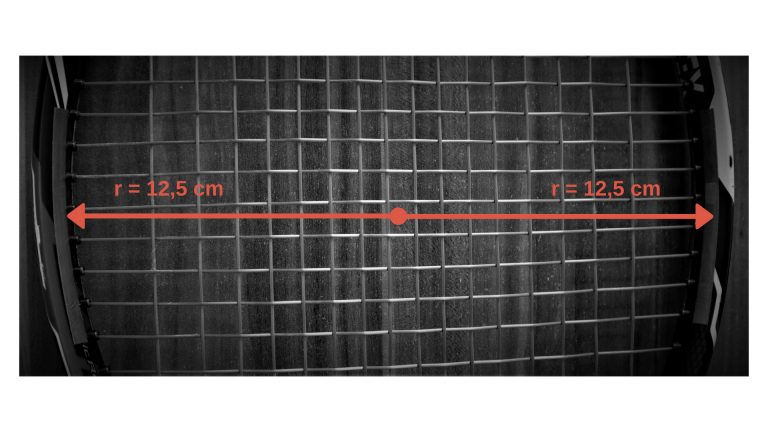
We know that the starting twistweight of the racket is 13,8 and we want to calculate the TW value for lead tape:
Lead tape (m=0,004 kg, y=12,5 cm)
We can calculate how much the 4 grams of lead tape adds to the twistweight of the racket as shown on the picture below.
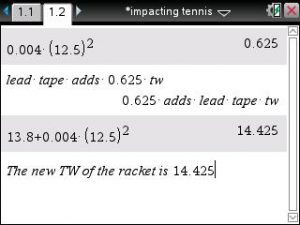
We can see that adding 4 g of lead tape only increased the TW for 0,625. That tells us that in order to significantly increase the twistweight, we would need to add a lot of mass, and that’s why the base twistweight of the racket is that more important.
All you need to know about twistweight
First of all, I would like to address some more misconceptions and problems around twistweight. You can see some players, most notably Novak Djokovic and Stan Wawrinka, that they have lead tape at 3&9 locations. The problem is that they use different rackets than their paint job would indicate and those rackets have lower twistweights. And they don’t necessarily have lead tape at 3&9 to increase the twistweight but also to evenly distribute the mass around the racket (this has to do with MGR/I value) and 3&9 locations happen to be the only way to add weight at those X coordinates, apart from using heavier strings (but let’s not get in to string weight here). Using the mentioned TWU database let’s take a look at Wawrinka’s actual racket (V CORE 95 D) and the paint job on the picture below.
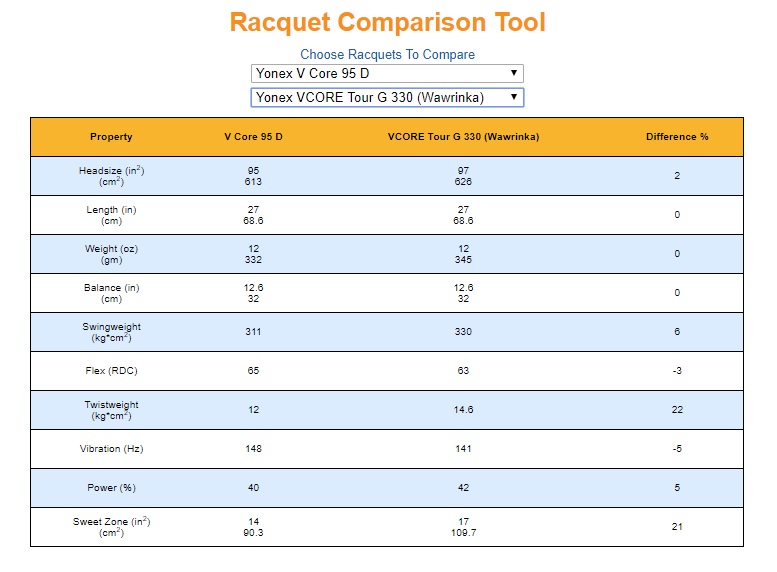
We can see that the difference is 22% in the twistweight department (12 vs 14, 6). Remember what I said before? We need to add a lot of weight to change the twistweight significantly. In fact, we would need to add more than 15 grams at 3&9 locations to get from 12 to 14,6 TW. So even after adding some lead tape Wawrinka’s TW really isn’t that high. Oh and if you think 20% is not much of a difference, you really should swing a racket with 14,6 TW and then a racket with 12 TW, but getting your hand on a racket with 12 TW might not be easy these days.
Conclusion on twistweight
- High twistweight is good for blocking and pushing the ball around. It requires a more linear swing path and is more forgiving and less maneuvrable. You might benefit from such rackets if you don’t hit the ball cleanly, have bad timing etc. or you have a more linear swing style or the so-called WTA strokes. Women on the tour usually have a more linear swing path and make the racket drop on the edge, and the racket continues in that position all the way to the contact.
- Low twistweight means more manoeuvrability, which means you can perfect your strokes, you can quickly adjust the racket face position, you can hit »whippier« shots and it rewards good technique, and clean ball striking.
- Low twistweight means you can increase the swingweight and still have a maneuvrable racket.
- Low twistweight is less forgiving and it requires more concentration, better footwork and in general more effort to play well with.
- In a perfect world a racket with a low twistweight and a higher swingweight has a higher ceiling, but again one should build the ceiling for his own abilities.